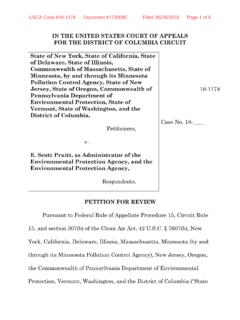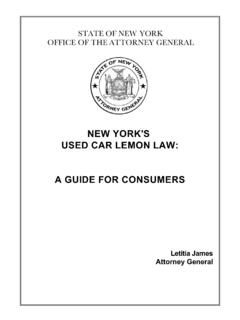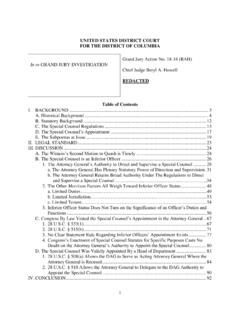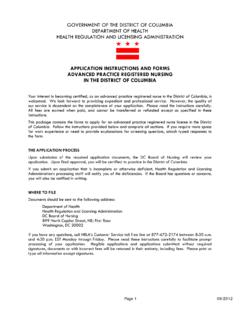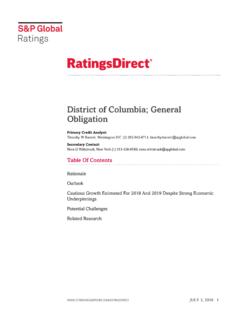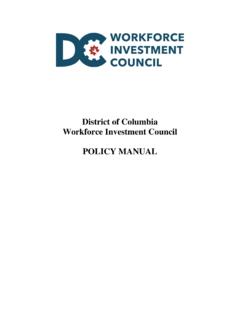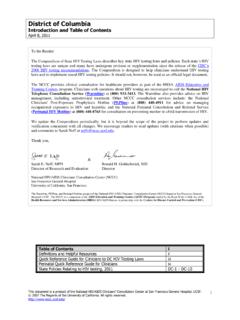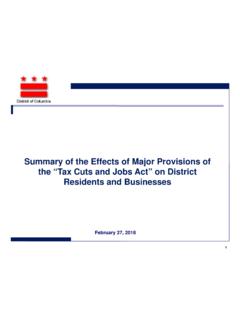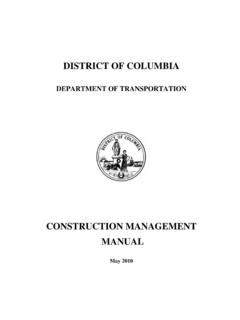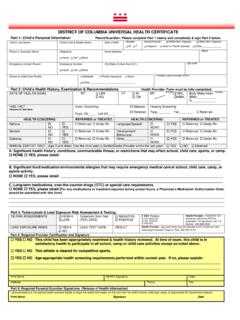Transcription of UNITED STATES DISTRICT COURT FOR THE DISTRICT OF …
1 1 UNITED STATES DISTRICT COURT FOR THE DISTRICT OF columbia STATE OF NEW YORK 28 Liberty Street, 19th Floor New York, NY 10005 Civ. Action No. 18-1747 COMPLAINT FOR DECLARATORY AND INJUNCTIVE RELIEF COMMONWEALTH OF MASSACHUSETTS One Ashburton Place Boston, MA 02108 DISTRICT OF columbia 441 4th Street, NW Suite 630 South Washington, DC 20001 STATE OF CALIFORNIA 1300 I Street, Suite 125 Box 944255 Sacramento, CA 94244-2550 STATE OF DELAWARE Carvel State Building, 6th Floor 820 North French Street Wilmington, DE 19801 COMMONWEALTH OF KENTUCKY 700 Capitol Avenue Capitol Building, Suite 118 Frankfort, KY 40601 STATE OF MARYLAND 200 St. Paul Place Baltimore, MD 21202 STATE OF NEW JERSEY Richard J. Hughes Justice Complex 25 Market Street, 8th Floor, West Wing Trenton, NJ 08625-0080 STATE OF OREGON 100 Market Street Portland, OR 97201 COMMONWEALTH OF PENNSYLVANIA Strawberry Square Harrisburg, PA 17120 COMMONWEALTH OF VIRGINIA 202 North Ninth Street Richmond, VA 23219 Case 1:18-cv-01747 Document 1 Filed 07/26/18 Page 1 of 562 STATE OF WASHINGTON 800 Fifth Avenue, Suite 2000 Seattle, WA 98104 Plaintiffs, v.
2 UNITED STATES DEPARTMENT OF LABOR 200 Constitution Avenue NW Washington, DC 20210 R. ALEXANDER ACOSTA, in his official capacity as Secretary of the UNITED STATES Department of Labor 200 Constitution Avenue NW Washington, DC 20210 and UNITED STATES OF AMERICA, Defendants. INTRODUCTION 1. This lawsuit challenges a Department of Labor final rule that upends a decades-old understanding of a foundational employee benefits law for the purpose of exempting a significant portion of the health insurance market from the Affordable Care Act s consumer protections. The rule accomplishes this objective by permitting a broad range of associations to offer health plans that do not have to comply with various Affordable Care Act protections. Through that mechanism, the rule increases the risk of fraud and harm to consumers, requires STATES to redirect significant enforcement resources to curb those risks, and jeopardizes state efforts to protect their residents through stronger regulation.
3 The rule is unlawful and should be vacated. 2. STATES have the responsibility to protect the health, safety and welfare of their citizens. Under the Patient Protection and Affordable Care Act (ACA),1 the STATES have made 1 Pub. L. No. 111-148, 124 Stat. 119 (2010). Case 1:18-cv-01747 Document 1 Filed 07/26/18 Page 2 of 563 enormous progress in decreasing uninsured rates, ensuring comprehensive coverage, and stabilizing the individual and small group health insurance markets. The uninsured rate nationwide dropped to nine percent in 2017, down from sixteen percent in The rule challenged here aims to undo this progress and will destabilize state insurance markets, increase fraud and abuse, decrease comprehensive health coverage, and substantially increase costs to the STATES . When health plans do not sufficiently cover health care or plans are no longer affordable, our residents suffer. 3. Prior to the ACA, health insurance markets for individuals and small employers (generally those with fifty or fewer employees) were subject to more premium volatility and abuse than the market for large employers (generally those with more than fifty employees).
4 Individual and small group insurance plans often lacked important coverage, and premiums were unaffordable because they were based on the health risk of the applicants either on an individual basis or as a small group. Health insurers adopted discriminatory practices to cherry-pick healthy people and to weed out those with pre-existing health conditions, leaving them uninsured or underinsured with coverage that did not cover medically necessary care. 4. In enacting the ACA, Congress targeted the individual and small group markets to ensure that individuals (including children) with pre-existing conditions like cancer or diabetes could purchase or maintain comprehensive coverage. In those markets, the ACA curtailed discrimination in premiums based on nearly all factors, including health, gender, age (limited to a certain narrow band), region, and occupation. The ACA requires that individual and small group plans cover an essential health benefits package that includes ten essential benefits, and 2 Nat l Ctr.
5 For Health Statistics, Health Insurance Coverage 2 (2018), at Case 1:18-cv-01747 Document 1 Filed 07/26/18 Page 3 of 564 so guarantees comprehensive coverage. The ACA further requires that insurers treat all enrollees in each of the individual and the small group markets whether healthy or sick as part of unified insurance pools. In short, a chief ACA purpose was to bar cherry-picking in pricing or benefits in the individual and small group markets. Because most large employers already offered comprehensive health insurance to their employees, the ACA did not impose the same array of reforms on the large group market, though some reforms did apply to the large group market as well. 5. One of President Trump s primary policy goals is to dismantle t he ACA. During his presidential campaign, President Trump promised to immediately repeal and replace the ACA, which he called a disaster. 3 Since taking office, the Trump Administration has engaged in a sustained effort to explode the On his first day in office, President Trump signed an Executive Order confirming this 6.
6 The rule challenged in this lawsuit is part of this Administration s broad effort to undermine the ACA. See 83 Fed. Reg. 28,912 (June 21, 2018) (to be codified at 29 pt. 2510) (hereinafter the Final Rule ). Announcing the Final Rule, the President proclaimed that it was another truly historic step in our efforts to rescue Americans from ObamaCare and the ObamaCare nightmare and would escape some of ObamaCare s most burdensome mandates. 6 3 See, , Donald Trump (@realDonaldTrump), Twitter (Oct. 15, 2016, 8:22 AM), 4 See Amy Goldstein & Juliet Eilperin, Affordable Care Act Remains Law of the Land, but Trump Vows to Explode It, WASH. POST, Mar. 24, 2017. 5 13765 of Jan. 20, 2017, Minimizing the Economic Burden of the Patient Protection and Affordable Care Act Pending Repeal, 82 Fed. Reg. 8351 (Jan. 24, 2017). 6 President Donald Trump, Remarks at the National Federation of Independent Businesses 75th Anniversary Celebration (June 19, 2018), at Case 1:18-cv-01747 Document 1 Filed 07/26/18 Page 4 of 565 7.
7 The Final Rule s purpose and effect are simple: to shift, through manipulation of the Employment Retirement Income Security Act (ERISA), a large number of small employers and individuals into the large group market because the ACA s core protections do not apply to that market. Worse yet, health plans created under the Final Rule would lack basic market incentives and statutory protections under federal law that apply to plans from true large employers. The results will be adults and children with less coverage and fewer benefits than Congress intended in all three markets (individual, small group, and large group), and destabilized individual and small group markets with premiums that may be unaffordable for people with pre-existing conditions who need the ACA s core protections. 8. The Final Rule reflects Secretary of Labor R. Alexander Acosta s belief that the choices made by Congress in the ACA to protect individuals and employees of small employers were backward. 7 However, as Congress understood, absent stronger protections, insurance in the individual and small group markets erected significant barriers to coverage through coverage caps, gaps, and outright denials, and led to vastly diverging premiums for people with pre-existing conditions.
8 The ACA reforms leveled the playing field for people in those markets. The Final Rule would return the country to the pre-ACA world where people with pre-existing conditions will lack federal protections that enable them to obtain quality, affordable health insurance. The White House s official transcript of these remarks is missing the word rescue, but video of the event available on C-SPAN shows that word in the President s remarks as delivered. See Announces Affordable Health Insurance Plan for Groups, C-SPAN (June 19, 2018) (beginning at 01:54), 7 Alexander Acosta, A Health Fix for Mom and Pop Shops, Wall St. J., June 18, 2018. Case 1:18-cv-01747 Document 1 Filed 07/26/18 Page 5 of 566 9. To undermine core ACA protections, the Department of Labor (DOL) in the Final Rule redefines the term employer in Section 3(5) of ERISA a law enacted in 1974 to protect employees by regulating employers pension and benefit plans in an unprecedented way that is contrary to ERISA and the ACA, and that violates the Administrative Procedure Act (APA).
9 Through this unlawful redefinition, the Final Rule expands the class of large employers under the ACA to include a broad range of associations. These associations may be formed for the primary purpose of selling insurance which, until now, has been unlawful. They may be composed of entirely unrelated and separate employers (including potentially all employers in a State) and purportedly self-employed individuals. The result: denying individuals and small groups who join health plans offered by such associations the ACA s core protections, while simultaneously undermining the single risk pools intended to spread risk across healthy and sick people in the market for comprehensive health insurance. 10. The Final Rule is unlawful in many respects. First, the Final Rule conflicts with the clear statutory structure that Congress adopted in the ACA to apply fundamental protections to the individual and small group markets. The Final Rule would achieve this unlawful goal by allowing associations composed of small employers and individuals to sponsor association health plans ( AHPs ) and then treating such plans as large group plans not subject to the strong consumer protections that the ACA imposes on health plans offered to small employers and individuals.
10 This maneuver violates the text, structure, and purpose of the ACA, which applied stronger protections in the individual and small group markets than in the large group market, in part because of the economic incentives of large employers incentives DOL admits associations and AHPs do not share. And while large plans are subject to a minimum actuarial comprehensiveness standard applied to large employers through the tax code, AHPs will avoid Case 1:18-cv-01747 Document 1 Filed 07/26/18 Page 6 of 567 this standard because the employers in the associations will remain small employers for tax code purposes. The result is health plans inferior to anything Congress intended for all three markets. 11. Second, the Final Rule conflicts with the ACA, ERISA, and established case law by enabling a purportedly self-employed individual (denominated a working owner ) with no other employees and with minimal income and verification to be both an employer and employee under ERISA with the authority to establish a group health plan.
